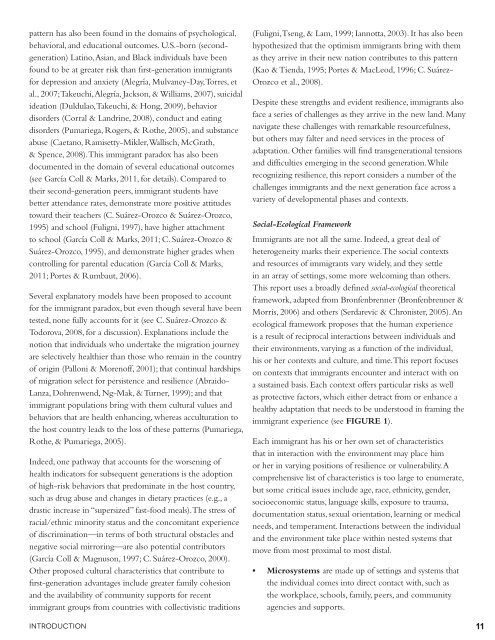Crossroads: The Psychology of Immigration in the New Century
Crossroads: The Psychology of Immigration in the New Century
Crossroads: The Psychology of Immigration in the New Century
Create successful ePaper yourself
Turn your PDF publications into a flip-book with our unique Google optimized e-Paper software.
pattern has also been found <strong>in</strong> <strong>the</strong> doma<strong>in</strong>s <strong>of</strong> psychological,<br />
behavioral, and educational outcomes. U.S.-born (secondgeneration)<br />
Lat<strong>in</strong>o, Asian, and Black <strong>in</strong>dividuals have been<br />
found to be at greater risk than first-generation immigrants<br />
for depression and anxiety (Alegría, Mulvaney-Day, Torres, et<br />
al., 2007; Takeuchi, Alegría, Jackson, & Williams, 2007), suicidal<br />
ideation (Duldulao, Takeuchi, & Hong, 2009), behavior<br />
disorders (Corral & Landr<strong>in</strong>e, 2008), conduct and eat<strong>in</strong>g<br />
disorders (Pumariega, Rogers, & Ro<strong>the</strong>, 2005), and substance<br />
abuse (Caetano, Ramisetty-Mikler, Wallisch, McGrath,<br />
& Spence, 2008). This immigrant paradox has also been<br />
documented <strong>in</strong> <strong>the</strong> doma<strong>in</strong> <strong>of</strong> several educational outcomes<br />
(see García Coll & Marks, 2011, for details). Compared to<br />
<strong>the</strong>ir second-generation peers, immigrant students have<br />
better attendance rates, demonstrate more positive attitudes<br />
toward <strong>the</strong>ir teachers (C. Suárez-Orozco & Suárez-Orozco,<br />
1995) and school (Fuligni, 1997), have higher attachment<br />
to school (García Coll & Marks, 2011; C. Suárez-Orozco &<br />
Suárez-Orozco, 1995), and demonstrate higher grades when<br />
controll<strong>in</strong>g for parental education (García Coll & Marks,<br />
2011; Portes & Rumbaut, 2006).<br />
Several explanatory models have been proposed to account<br />
for <strong>the</strong> immigrant paradox, but even though several have been<br />
tested, none fully accounts for it (see C. Suárez-Orozco &<br />
Todorova, 2008, for a discussion). Explanations <strong>in</strong>clude <strong>the</strong><br />
notion that <strong>in</strong>dividuals who undertake <strong>the</strong> migration journey<br />
are selectively healthier than those who rema<strong>in</strong> <strong>in</strong> <strong>the</strong> country<br />
<strong>of</strong> orig<strong>in</strong> (Palloni & Moren<strong>of</strong>f, 2001); that cont<strong>in</strong>ual hardships<br />
<strong>of</strong> migration select for persistence and resilience (Abraido-<br />
Lanza, Dohrenwend, Ng-Mak, & Turner, 1999); and that<br />
immigrant populations br<strong>in</strong>g with <strong>the</strong>m cultural values and<br />
behaviors that are health enhanc<strong>in</strong>g, whereas acculturation to<br />
<strong>the</strong> host country leads to <strong>the</strong> loss <strong>of</strong> <strong>the</strong>se patterns (Pumariega,<br />
Ro<strong>the</strong>, & Pumariega, 2005).<br />
Indeed, one pathway that accounts for <strong>the</strong> worsen<strong>in</strong>g <strong>of</strong><br />
health <strong>in</strong>dicators for subsequent generations is <strong>the</strong> adoption<br />
<strong>of</strong> high-risk behaviors that predom<strong>in</strong>ate <strong>in</strong> <strong>the</strong> host country,<br />
such as drug abuse and changes <strong>in</strong> dietary practices (e.g., a<br />
drastic <strong>in</strong>crease <strong>in</strong> “supersized” fast-food meals). <strong>The</strong> stress <strong>of</strong><br />
racial/ethnic m<strong>in</strong>ority status and <strong>the</strong> concomitant experience<br />
<strong>of</strong> discrim<strong>in</strong>ation—<strong>in</strong> terms <strong>of</strong> both structural obstacles and<br />
negative social mirror<strong>in</strong>g—are also potential contributors<br />
(García Coll & Magnuson, 1997; C. Suárez-Orozco, 2000).<br />
O<strong>the</strong>r proposed cultural characteristics that contribute to<br />
first-generation advantages <strong>in</strong>clude greater family cohesion<br />
and <strong>the</strong> availability <strong>of</strong> community supports for recent<br />
immigrant groups from countries with collectivistic traditions<br />
INTRODUCTION<br />
(Fuligni, Tseng, & Lam, 1999; Iannotta, 2003). It has also been<br />
hypo<strong>the</strong>sized that <strong>the</strong> optimism immigrants br<strong>in</strong>g with <strong>the</strong>m<br />
as <strong>the</strong>y arrive <strong>in</strong> <strong>the</strong>ir new nation contributes to this pattern<br />
(Kao & Tienda, 1995; Portes & MacLeod, 1996; C. Suárez-<br />
Orozco et al., 2008).<br />
Despite <strong>the</strong>se strengths and evident resilience, immigrants also<br />
face a series <strong>of</strong> challenges as <strong>the</strong>y arrive <strong>in</strong> <strong>the</strong> new land. Many<br />
navigate <strong>the</strong>se challenges with remarkable resourcefulness,<br />
but o<strong>the</strong>rs may falter and need services <strong>in</strong> <strong>the</strong> process <strong>of</strong><br />
adaptation. O<strong>the</strong>r families will f<strong>in</strong>d transgenerational tensions<br />
and difficulties emerg<strong>in</strong>g <strong>in</strong> <strong>the</strong> second generation. While<br />
recogniz<strong>in</strong>g resilience, this report considers a number <strong>of</strong> <strong>the</strong><br />
challenges immigrants and <strong>the</strong> next generation face across a<br />
variety <strong>of</strong> developmental phases and contexts.<br />
Social-Ecological Framework<br />
Immigrants are not all <strong>the</strong> same. Indeed, a great deal <strong>of</strong><br />
heterogeneity marks <strong>the</strong>ir experience. <strong>The</strong> social contexts<br />
and resources <strong>of</strong> immigrants vary widely, and <strong>the</strong>y settle<br />
<strong>in</strong> an array <strong>of</strong> sett<strong>in</strong>gs, some more welcom<strong>in</strong>g than o<strong>the</strong>rs.<br />
This report uses a broadly def<strong>in</strong>ed social-ecological <strong>the</strong>oretical<br />
framework, adapted from Bronfenbrenner (Bronfenbrenner &<br />
Morris, 2006) and o<strong>the</strong>rs (Serdarevic & Chronister, 2005). An<br />
ecological framework proposes that <strong>the</strong> human experience<br />
is a result <strong>of</strong> reciprocal <strong>in</strong>teractions between <strong>in</strong>dividuals and<br />
<strong>the</strong>ir environments, vary<strong>in</strong>g as a function <strong>of</strong> <strong>the</strong> <strong>in</strong>dividual,<br />
his or her contexts and culture, and time. This report focuses<br />
on contexts that immigrants encounter and <strong>in</strong>teract with on<br />
a susta<strong>in</strong>ed basis. Each context <strong>of</strong>fers particular risks as well<br />
as protective factors, which ei<strong>the</strong>r detract from or enhance a<br />
healthy adaptation that needs to be understood <strong>in</strong> fram<strong>in</strong>g <strong>the</strong><br />
immigrant experience (see FIGURE 1).<br />
Each immigrant has his or her own set <strong>of</strong> characteristics<br />
that <strong>in</strong> <strong>in</strong>teraction with <strong>the</strong> environment may place him<br />
or her <strong>in</strong> vary<strong>in</strong>g positions <strong>of</strong> resilience or vulnerability. A<br />
comprehensive list <strong>of</strong> characteristics is too large to enumerate,<br />
but some critical issues <strong>in</strong>clude age, race, ethnicity, gender,<br />
socioeconomic status, language skills, exposure to trauma,<br />
documentation status, sexual orientation, learn<strong>in</strong>g or medical<br />
needs, and temperament. Interactions between <strong>the</strong> <strong>in</strong>dividual<br />
and <strong>the</strong> environment take place with<strong>in</strong> nested systems that<br />
move from most proximal to most distal.<br />
• Microsystems are made up <strong>of</strong> sett<strong>in</strong>gs and systems that<br />
<strong>the</strong> <strong>in</strong>dividual comes <strong>in</strong>to direct contact with, such as<br />
<strong>the</strong> workplace, schools, family, peers, and community<br />
agencies and supports.<br />
11
















